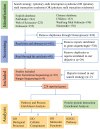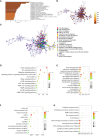Re-analysis of gene mutations found in pituitary stalk interruption syndrome and a new hypothesis on the etiology
- PMID: 38464967
- PMCID: PMC10920343
- DOI: 10.3389/fendo.2024.1338781
Re-analysis of gene mutations found in pituitary stalk interruption syndrome and a new hypothesis on the etiology
Abstract
Background: Pituitary stalk interruption syndrome (PSIS) is a complex clinical syndrome characterized by varied pituitary hormone deficiencies, leading to severe manifestations across multiple systems. These include lifelong infertility, short stature, mental retardation, and potentially life-threatening pituitary crises if not promptly diagnosed and treated. Despite extensive research, the precise pathogenesis of PSIS remains unclear. Currently, there are two proposed theories regarding the pathogenic mechanisms: the genetic defect theory and the perinatal injury theory.
Methods: We systematically searched English databases (PubMed, Web of Science, Embase) and Chinese databases (CNKI, WanFang Med Online, Sinomed) up to February 24, 2023, to summarize studies on gene sequencing in PSIS patients. Enrichment analyses of reported mutated genes were subsequently performed using the Metascape platform.
Results: Our study included 37 articles. KEGG enrichment analysis revealed mutated genes were enriched in the Notch signaling pathway, Wnt signaling pathway, and Hedgehog signaling pathway. GO enrichment analysis demonstrated mutated genes were enriched in biological processes such as embryonic development, brain development, axon development and guidance, and development of other organs.
Conclusion: Based on our summary and analyses, we propose a new hypothesis: disruptions in normal embryonic development, partially stemming from the genetic background and/or specific gene mutations in individuals, may increase the likelihood of abnormal fetal deliveries, where different degrees of traction during delivery may lead to different levels of pituitary stalk interruption and posterior lobe ectopia. The clinical diversity observed in PSIS patients may result from a combination of genetic background, specific mutations, and variable degrees of traction during delivery.
Keywords: enrichment analysis; etiological hypothesis; gene sequencing; pituitary stalk interruption syndrome; traction during delivery.
Copyright © 2024 Wang, Qin, Jiang, Xiao, Ye, Jiang and Guo.
Conflict of interest statement
The authors declare that the research was conducted in the absence of any commercial or financial relationships that could be construed as a potential conflict of interest. The reviewer ZL declared a shared affiliation with the authors SW, DJ, YX, LY, and QG to the handling editor at the time of review.
Figures




Similar articles
-
Pituitary stalk interruption syndrome.Handb Clin Neurol. 2021;181:9-27. doi: 10.1016/B978-0-12-820683-6.00002-6. Handb Clin Neurol. 2021. PMID: 34238482 Review.
-
Multi-genic pattern found in rare type of hypopituitarism: a whole-exome sequencing study of Han Chinese with pituitary stalk interruption syndrome.J Cell Mol Med. 2017 Dec;21(12):3626-3632. doi: 10.1111/jcmm.13272. Epub 2017 Jul 14. J Cell Mol Med. 2017. PMID: 28707430 Free PMC article.
-
Pituitary Stalk Interruption Syndrome: From Clinical Findings to Pathogenesis.J Neuroendocrinol. 2017 Jan;29(1). doi: 10.1111/jne.12451. J Neuroendocrinol. 2017. PMID: 27917547 Review.
-
CDON gene contributes to pituitary stalk interruption syndrome associated with unilateral facial and abducens nerve palsy.J Appl Genet. 2021 Dec;62(4):621-629. doi: 10.1007/s13353-021-00649-w. Epub 2021 Jul 8. J Appl Genet. 2021. PMID: 34235642 Free PMC article.
-
Mutations in the Human ROBO1 Gene in Pituitary Stalk Interruption Syndrome.J Clin Endocrinol Metab. 2017 Jul 1;102(7):2401-2406. doi: 10.1210/jc.2016-1095. J Clin Endocrinol Metab. 2017. PMID: 28402530
Cited by
-
Risk factors and prediction model of metabolic disorders in adult patients with pituitary stalk interruption syndrome.Sci Rep. 2025 Mar 5;15(1):7740. doi: 10.1038/s41598-025-91461-7. Sci Rep. 2025. PMID: 40044792 Free PMC article.
-
Pituitary stalk interruption syndrome with coexistent focal cortical dysplasia in a young boy.BMJ Case Rep. 2025 Jan 14;18(1):e262020. doi: 10.1136/bcr-2024-262020. BMJ Case Rep. 2025. PMID: 39809477 Free PMC article.
References
Publication types
MeSH terms
Substances
LinkOut - more resources
Full Text Sources
Medical

